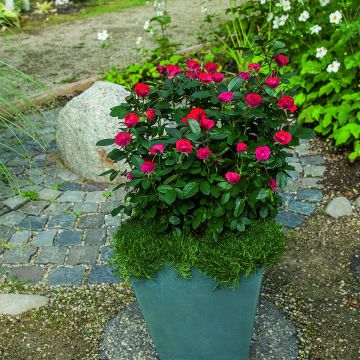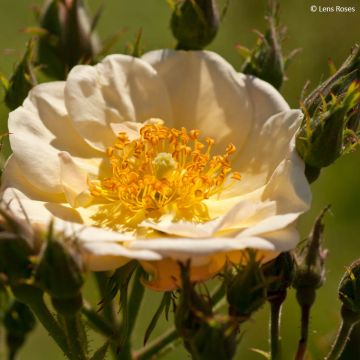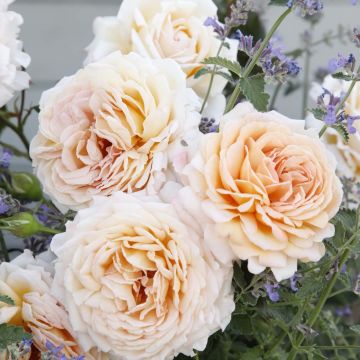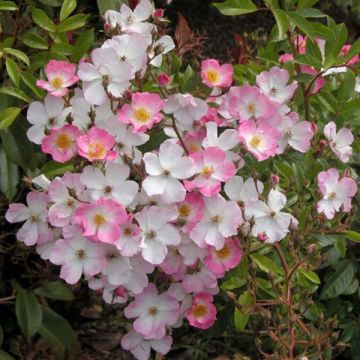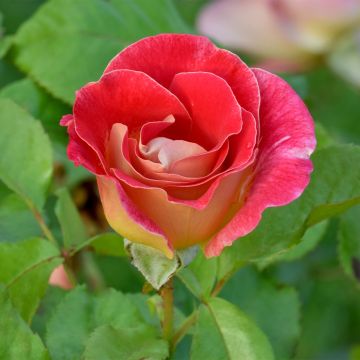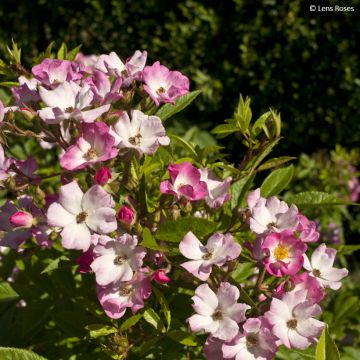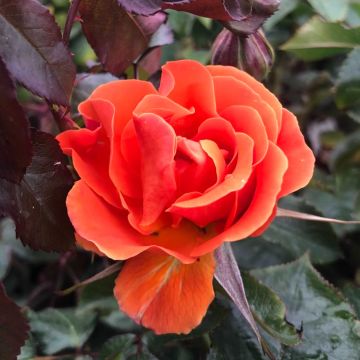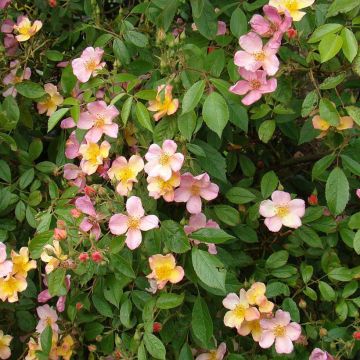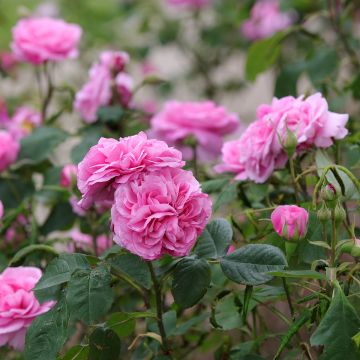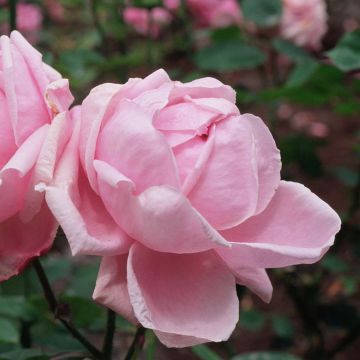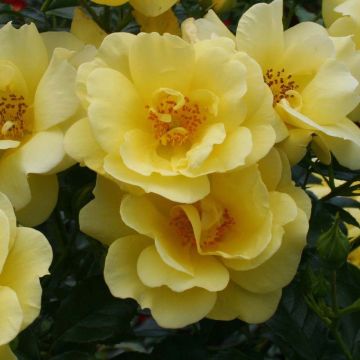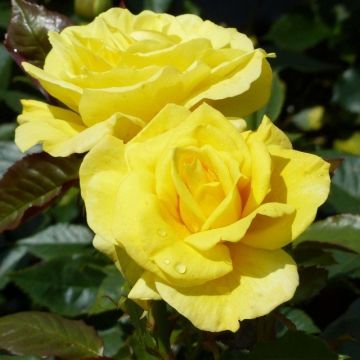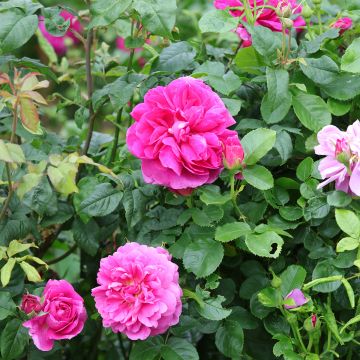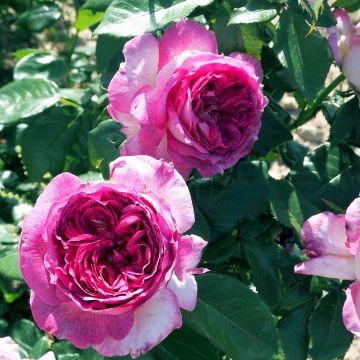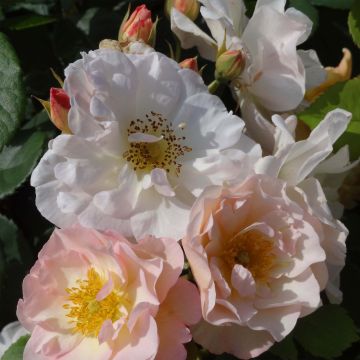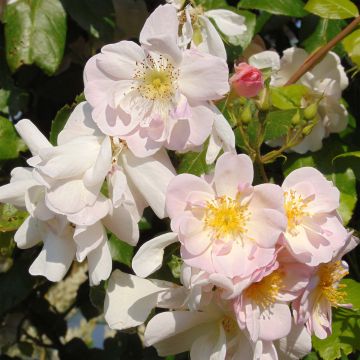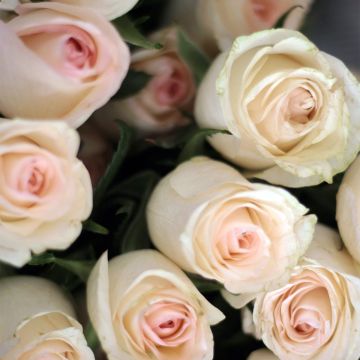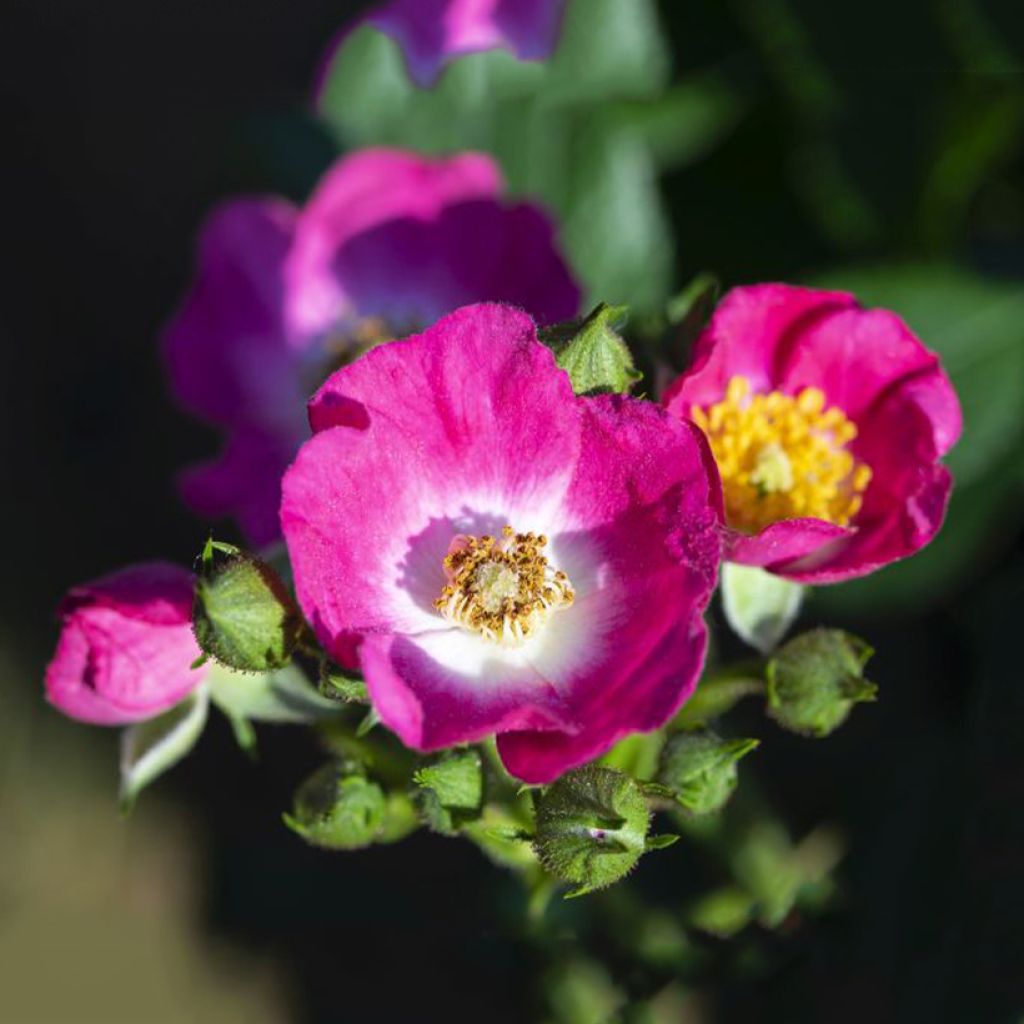

Rosa Rosy Boom Mini
Rosa Rosy Boom Mini
Rosa Rosy Boom® Mini
Rose
This item cannot be shipped to the selected country
Delivery charge from €5.90
More information
Schedule delivery date,
and select date in basket
This plant carries a 24 months recovery warranty
More information
We guarantee the quality of our plants for a full growing cycle, and will replace at our expense any plant that fails to recover under normal climatic and planting conditions.
From €5.90 for pickup delivery and €6.90 for home delivery
Express home delivery from €8.90.

Does this plant fit my garden?
Set up your Plantfit profile →
Description
The 'Rosy Boom Mini' Bush Rose is a dwarf bush rose with a disarmingly simple beauty: low-maintenance and long-lasting flowering, abundant small flowers with fragrant white-centred cups and yellow stamens, ranging in colour from pink to magenta, constantly renewing themselves on a tiny bush from June to September. Resembling the flowering of hydrangeas in panicles, they are sturdy and not afraid of rain. This hardy, healthy, and compact selection is easily pruned once a year. It forms a bush with a natural yet modern look, perfect for planting along borders or in pots.
The Rosy Boom Mini Bush Rose has a bushy habit, reaching an average height of 50 cm (20in) with a width of 30 to 40 cm (12 to 16in) at maturity, making it suitable for even the smallest spaces. Its flowering is particularly abundant and regular from June to September, provided the soil remains moist. Its small roses, measuring 4 cm (2in) wide, are gathered in generous panicles. They are slightly flattened cups with a white colour strongly edged with bright pink to magenta, a shade that fades as they fully bloom, offering a beautiful blend of pink and white. The stems are adorned with healthy deciduous foliage consisting of leaflets in a medium green colour with a satin finish. The bush has a moderate growth rate.
Landscape roses are ideal for creating beautiful small hedges planted alongside terraces or in beds with small shrubs. Combine them with abelias, nandinas, deciduous ceanothus, roses or caryopteris, for example. They are great companions for peonies, paniculate phlox, and tall baby's breath. The small size of Rosy Boom Mini allows it to fit in any garden, even the smallest ones, or on the tiniest balconies. Mix it with easy-care perennial plants like Rozanne geraniums, small-flowered carnations, perennial sage, or pink and blue asters.
Report an error about the product description
Rosa Rosy Boom Mini in pictures
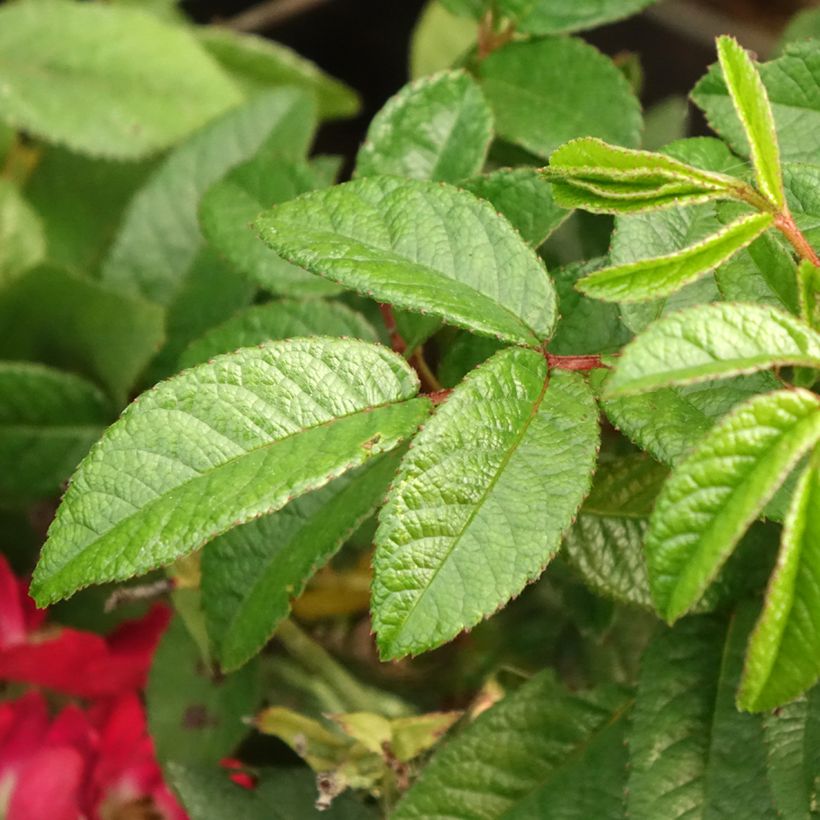

Plant habit
Flowering
Foliage
Botanical data
Rosa
Rosy Boom® Mini
Rosaceae
Rose
Cultivar or hybrid
Other Polyantha clustered Roses
Planting and care
The 'Rosy Boom Mini' rose is not demanding; it thrives in all regions that are not too hot and do not fear diseases, cold, or rain. Plant it in well-worked and well-drained ordinary soil and in a sunny or partially shaded location, which it tolerates very well. Perfectly hardy, this rose can withstand temperatures as low as -20°.
Roses prefer a sunny position (at least 4 to 5 hours of sun per day) but are protected from the scorching midday sun and strong winds. They appreciate loose, permeable, and rich soils. They will adapt to any garden if the soil is well-prepared and sufficiently fertile. To plant your rose in a pot, work the soil to a depth of 25 cm (10in), crumble the soil well, and place a bottom amendment such as blood, fish and bone in the planting hole. Position your plant free from its pot, thoroughly covering the top of the root ball with 3 cm (1in) of soil, backfill, and water to remove air pockets. Regular watering for a few weeks is necessary in dry weather to facilitate root establishment. Also, remember to provide your rose with a special rose fertiliser that stimulates plant flowering.
Roses are often stained or unsightly at the end of summer, but this is not a problem for their development. These spots are not harmful to the rose but are natural.
Planting period
Intended location
Care
-
, onOrder confirmed
Reply from on Promesse de fleurs
Roses by purpose
Haven't found what you were looking for?
Hardiness is the lowest winter temperature a plant can endure without suffering serious damage or even dying. However, hardiness is affected by location (a sheltered area, such as a patio), protection (winter cover) and soil type (hardiness is improved by well-drained soil).

Photo Sharing Terms & Conditions
In order to encourage gardeners to interact and share their experiences, Promesse de fleurs offers various media enabling content to be uploaded onto its Site - in particular via the ‘Photo sharing’ module.
The User agrees to refrain from:
- Posting any content that is illegal, prejudicial, insulting, racist, inciteful to hatred, revisionist, contrary to public decency, that infringes on privacy or on the privacy rights of third parties, in particular the publicity rights of persons and goods, intellectual property rights, or the right to privacy.
- Submitting content on behalf of a third party;
- Impersonate the identity of a third party and/or publish any personal information about a third party;
In general, the User undertakes to refrain from any unethical behaviour.
All Content (in particular text, comments, files, images, photos, videos, creative works, etc.), which may be subject to property or intellectual property rights, image or other private rights, shall remain the property of the User, subject to the limited rights granted by the terms of the licence granted by Promesse de fleurs as stated below. Users are at liberty to publish or not to publish such Content on the Site, notably via the ‘Photo Sharing’ facility, and accept that this Content shall be made public and freely accessible, notably on the Internet.
Users further acknowledge, undertake to have ,and guarantee that they hold all necessary rights and permissions to publish such material on the Site, in particular with regard to the legislation in force pertaining to any privacy, property, intellectual property, image, or contractual rights, or rights of any other nature. By publishing such Content on the Site, Users acknowledge accepting full liability as publishers of the Content within the meaning of the law, and grant Promesse de fleurs, free of charge, an inclusive, worldwide licence for the said Content for the entire duration of its publication, including all reproduction, representation, up/downloading, displaying, performing, transmission, and storage rights.
Users also grant permission for their name to be linked to the Content and accept that this link may not always be made available.
By engaging in posting material, Users consent to their Content becoming automatically accessible on the Internet, in particular on other sites and/or blogs and/or web pages of the Promesse de fleurs site, including in particular social pages and the Promesse de fleurs catalogue.
Users may secure the removal of entrusted content free of charge by issuing a simple request via our contact form.
The flowering period indicated on our website applies to countries and regions located in USDA zone 8 (France, the United Kingdom, Ireland, the Netherlands, etc.)
It will vary according to where you live:
- In zones 9 to 10 (Italy, Spain, Greece, etc.), flowering will occur about 2 to 4 weeks earlier.
- In zones 6 to 7 (Germany, Poland, Slovenia, and lower mountainous regions), flowering will be delayed by 2 to 3 weeks.
- In zone 5 (Central Europe, Scandinavia), blooming will be delayed by 3 to 5 weeks.
In temperate climates, pruning of spring-flowering shrubs (forsythia, spireas, etc.) should be done just after flowering.
Pruning of summer-flowering shrubs (Indian Lilac, Perovskia, etc.) can be done in winter or spring.
In cold regions as well as with frost-sensitive plants, avoid pruning too early when severe frosts may still occur.
The planting period indicated on our website applies to countries and regions located in USDA zone 8 (France, United Kingdom, Ireland, Netherlands).
It will vary according to where you live:
- In Mediterranean zones (Marseille, Madrid, Milan, etc.), autumn and winter are the best planting periods.
- In continental zones (Strasbourg, Munich, Vienna, etc.), delay planting by 2 to 3 weeks in spring and bring it forward by 2 to 4 weeks in autumn.
- In mountainous regions (the Alps, Pyrenees, Carpathians, etc.), it is best to plant in late spring (May-June) or late summer (August-September).
The harvesting period indicated on our website applies to countries and regions in USDA zone 8 (France, England, Ireland, the Netherlands).
In colder areas (Scandinavia, Poland, Austria...) fruit and vegetable harvests are likely to be delayed by 3-4 weeks.
In warmer areas (Italy, Spain, Greece, etc.), harvesting will probably take place earlier, depending on weather conditions.
The sowing periods indicated on our website apply to countries and regions within USDA Zone 8 (France, UK, Ireland, Netherlands).
In colder areas (Scandinavia, Poland, Austria...), delay any outdoor sowing by 3-4 weeks, or sow under glass.
In warmer climes (Italy, Spain, Greece, etc.), bring outdoor sowing forward by a few weeks.


































